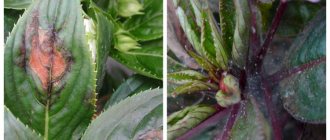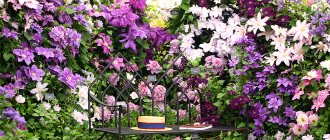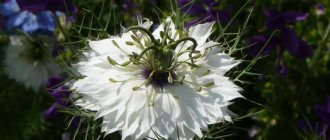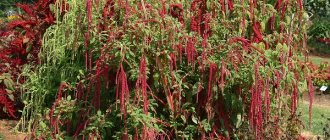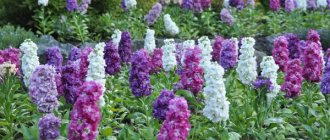Among them there are plain and variegated ones of all shades and combinations of white, pink, yellow, orange, red. Low bush varieties with low branching have been developed, which during the flowering season give the impression of living, rooted bouquets.
All these wonderful achievements of breeders require mandatory shelter in warm rooms in the middle zone, at least in the autumn-winter period.
Terry balsams can be grown entirely indoors. The answer to the question - “How do terry indoor Impalers grow?” you will find below.
Variety of terry balsam varieties
Thanks to the efforts of flower growers, home collections have been replenished with varieties with double flowers, which quickly gained popularity. The most famous varieties of hybrid:
- Sparkler Cherry (Russian: Sparkling cherry) - a lush bush covered with dark green leaves. Pleases with the continuous blooming of large double flowers of bright cherry color.
- Sparkler Salmon – (Russian: Sparkling salmon) is a profusely flowering hybrid. Double flowers are pale pink with white veins.
- Ole Peppermint is a low growing shrub with variegated foliage and pink and crimson double flowers.
- Apple Blossom (Russian: Apple blossom) is a bushy plant with double flowers of soft pink shades. The middle usually has a darker shade. The petals lighten as they open.
- Coral Bells (Russian: Coral bells) is a magnificent ampelous hybrid with coral-orange drooping flowers.
- Balsamina Red (Russian: Red balsam) - has become widespread. Widely used in indoor and garden plant growing. Red double flowers stand out against the background of dark green foliage, which is why it received the second name “Ogonyok”.
- Purple Pinata – attracts attention with lush purple flowers against light green foliage. From a distance the flowers resemble small peonies.
This is not a complete list of hybrid varieties with beautiful flowers. The rich palette of colors contains all shades of red, white, purple, orange.
LiveInternetLiveInternet
–Categories
- embroidery (47)
- Hacienda (27)
- vegetable garden (15)
- Flowers (17)
- Beads (15)
- soutache (11)
- from newspaper tubes (7)
- Knitting (508)
- Cardigan, sweater. (101)
- Knitting patterns (76)
- Crochet patterns (54)
- For kids (27)
- Magazines (19)
- Missoni pattern (5)
- Jacquard (5)
- From packages (3)
- Leaves, flowers (23)
- Socks, slippers (20)
- Finishing of collars, sleeves. (thirty)
- Napkins, potholders, blankets, capes (29)
- Dresses, skirts (89)
- Hats, beanies, scarves. (45)
- For yourself beloved (38)
- Toys (411)
- Description of dolls (67)
- Description of animals (31)
- Description of bears (28)
- Keychains (28)
- Description of hares (22)
- Description of cartoon characters (22)
- Accessories (21)
- Description of cats (19)
- Description of dogs (16)
- New Year (13)
- Description of horses (13)
- Description of monkeys (10)
- Description of sheep (9)
- Description of hedgehogs (8)
- flowers (7)
- Description of elephants (5)
- Description of equipment (5)
- Description of gnomes (5)
- Eyes, hair (39)
- Mount (11)
- Finger (12)
- Arms, legs, tail (5)
- home ideas (113)
- lampshade (2)
- Stained glass (5)
- Rugs (15)
- Blankets, rugs, pillows (4)
- Tips (21)
- Bags (40)
- Stencils, templates (14)
- landscape design (2)
- Macrame (3)
- My works (20)
- recipes (66)
- Baking (37)
- Blanks (5)
- Hot (6)
- Dessert (2)
- Drinks (2)
- Salads (11)
- Sauces (2)
–Search by diary
–Subscription by e-mail
-Statistics
Caring for balsam during flowering and dormancy
During flowering, wet Vanka does not require special care. The only limitation during this period is that it is better not to irrigate the plant with a sprayer, or to do it very carefully so that moisture does not get on the flowers.
Not only the bright flowers attract attention, but also the juicy, richly colored leaves.
You should also prevent shoots from overgrowing. To do this, they should be pinched at the top, due to which the side shoots begin to develop more actively, and the formation of the plant allows you to grow a more lush bush. Shoots that are too elongated are pruned (they can be used for cuttings) - spring is best suited for this procedure.
During the dormant period, when winter sets in, watering of balsam is gradually reduced.
Reproduction
Terry balsam is propagated vegetatively , since only this method guarantees the preservation of all varietal characteristics in the daughter plants.
Propagation by cuttings
Spring apical cuttings 7-10 cm long, which have 2-3 internodes, take root well.
The lower leaves are removed.
You can pre-root the cuttings in water, or immediately plant them in a moistened light earthen mixture, cover with plastic wrap, maintain humidity, ventilate and keep them in a bright place at a temperature of about 17 degrees.
After two weeks, the cuttings begin to grow, and after 2-3 months they are ready to bloom.
What kind of plant is this?
Botanical description
Impatiens is a perennial, herbaceous, flowering plant of the impatiens family. It has many types, series and varieties.
Terry balsam is a type of hybrid . Unlike ordinary plants, the flowers of double varieties are not flat, but full, like those of a rose or carnation.
History of origin
Most plant varieties were bred by breeders in the mid-20th century. They first appeared on the shelves of US flower shops in the 1950s. However, some varieties were popular already at the beginning of the 19th century. The most famous of them is Waller's balsam. It has been known since the century before last not only in Europe and America, but also in Russia.
Basic rules for growing balsam indoors
Creating an optimal microclimate and proper care at home contribute to year-round flowering of the hybrid. The herbaceous shrub is not particularly capricious. However, it is important not to stress the plant. Impatiens often react to sudden changes by dropping flowers and buds.
The basic rules of agricultural technology are as follows:
- Diffused lighting is preferable, despite the fact that terry balsam is a light-loving plant. On southern windows it should be shaded from 10 a.m. to 5 p.m. to prevent intense loss of moisture. Excess sunlight and lack of moisture are indicated by drooping leaves of herbaceous shrubs. In addition, stems and shoots lose turgor.
- Additional lighting in winter promotes abundant year-round flowering. Balsam does not have a pronounced dormant period. On northern windows, the intensity of flowering is significantly reduced. Impatiens are distinguished by their high ability to adapt to new growing conditions. Stress provokes the loss of flowers and buds. In favorable conditions, flowering resumes after one to two weeks.
- The optimal temperature for the spring-summer period is within +20+25°C. In a cooler room, balsam quickly ages and rarely produces flowers. In addition, overcooling of the root system leads to its rotting and death of the bush.
- Air humidity does not play a decisive role for Vanka wet. An increase in ambient temperature to +22°C requires mandatory spraying to reduce overheating of the aboveground part of the bush. In a cool room, the plant is not sprayed so as not to cause hypothermia. An indicator of optimal air and substrate humidity is the high turgor of balsam stems and leaves.
- The watering schedule depends on the period of the year, the ambient temperature and the length of daylight hours. From early spring to mid-autumn, watering is carried out twice a week. Be sure to wait until the top layer of the substrate dries. As daylight hours shorten, increase the interval between waterings. The next watering is done one or two days after the soil dries. In winter, it is necessary to drain excess water from the pan. Insufficient watering can lead to drying out of the roots, while excess moisture creates conditions for their rotting.
- Fertilizing is applied only in the spring and summer and no more than twice a month. Preference is given to mineral complexes for flowering indoor plants. The concentration of the solution should be half that recommended on the package.
Diseases of Impatiens
Like other indoor plants, balsam is susceptible, especially if the maintenance regime is not maintained, to various bacterial diseases.
Root rot
Excess moisture, with uncontrolled watering, sometimes leads to rotting of the root system. The so-called root rot. In the early stages of the manifestation of this insidious disease, the plant can be saved. It is necessary to remove the damaged roots and replant the flower in new soil.
Gray rot
Brown spots appeared on the leaves, and the stems became covered with a white coating - this is a fungal infection, Gray rot. The disease appears due to improper maintenance of the flower.
The bush should be urgently transplanted into a new pot, and also treated with a fungicidal drug (Abiga-Pik, Oxychom, Vectra, Discor). Do not allow water to stagnate in the pan. You should use settled water at room temperature for irrigation.
Powdery mildew
During the hottest periods of the summer season, balsam can develop such a dangerous disease as powdery mildew. The causative agent of the disease can completely destroy the plant in a matter of days. How to save? All affected parts of the plant should be removed. Transplant into a new pot with new substrate. Spray the flower with fungicide (Skor, Topaz).
Bacteriosis
There are bacterial diseases in which it will not be possible to save the indoor balsam plant. The diseased specimen should be destroyed.
This disease occurs against a background of low temperatures with excess moisture. To prevent this from happening, compliance with the plant maintenance rules is required.
Planting and transplanting
Impatiens does not place high demands on the composition of the soil. When planting and replanting impatiens, the basic rules for mandatory drainage of the flowerpot apply. It is preferable to plant in low, large-diameter flowerpots, since the fibrous root system does not penetrate very deeply. Transplantation using the transshipment method is carried out in early spring, on the eve of the active growing season. The first watering is carried out immediately after compaction of the substrate.
Double balsam blooms more profusely when the roots are a little cramped in the pot.
It is not recommended to grow balsam for more than two to three years due to its rapid aging. Given its easy propagation, it would be preferable to rejuvenate the plant by cuttings.


